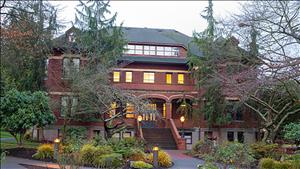Seattle Pacific University, on the north side of Queen Anne Hill, started in 1891 as an elementary school with a goal to train missionaries. By 2001, it had grown to almost 3,500 students and offered accredited programs in education, theology, nursing, and engineering.
In 1891, the Oregon and Washington Conference of The Free Methodist Church voted to establish a school to train missionaries. The teachers would represent the highest in Christian values. The Free Methodist Church sought to recover the evangelical position of John Wesley (1703-1791). Free Methodists supported the abolition of slavery and opposed the practice of renting church pews to worshippers (resulting in the name Free).
Nils B. Peterson, an early homesteader on Queen Anne Hill in Seattle, donated five acres of land from his garden. Queen Anne minister and banker Hiram Pease, and Conference Chairman John C. Nortton set about raising funds. Educators Alexander and Adelaide Beers were recruited from Virginia to head the new school to be called Seattle Seminary.
Classes commenced on April 4, 1891, for 34 elementary school students. The first building was called The Red Brick Building, but was later named Alexander Hall after the first principal. Under the Beers' leadership, the school grew to four buildings. In 1910, college-level courses were added and three years later, it was named Seattle Seminary and College. In 1915, it became Seattle Pacific College and produced its first five graduates.
In the 1920s, Seattle Pacific established a teacher college and enrollment grew from 40 to 400. In 1936, Seattle Pacific was accredited as a four-year college.
After World War II, enrollment ballooned to 1400 and more buildings were added. Camp Casey, a 155-acre campus for outdoor education on Whidbey Island, was acquired in 1955. In the 1960s, 15 more buildings were constructed and the older structures were remodeled. The campus grew beyond its original five acres to 45 acres.
In 1940, the college partnered with the city of Seattle to develop Nils Peterson's sand pit on 3rd Avenue W into the Queen Anne Bowl playfield. This partnership was repeated in developing Wallace Athletic Field on W Nickerson Street adjacent to the school's Royal Brougham Pavilion.
In the 1970s, the college reorganized its academic structure along a university model. On June 5, 1977, Seattle Pacific became a university. In 2001, SPU offered 52 undergraduate majors, 40 minors, 11 master's degree programs and two doctoral programs.

